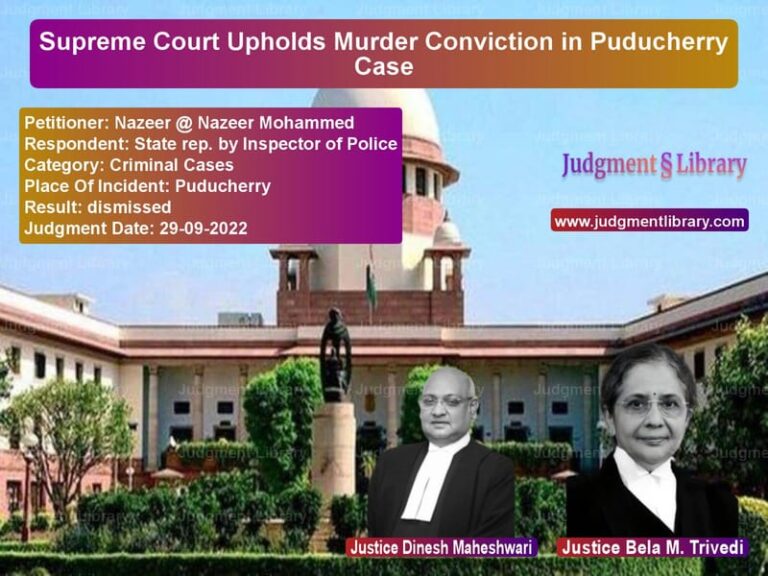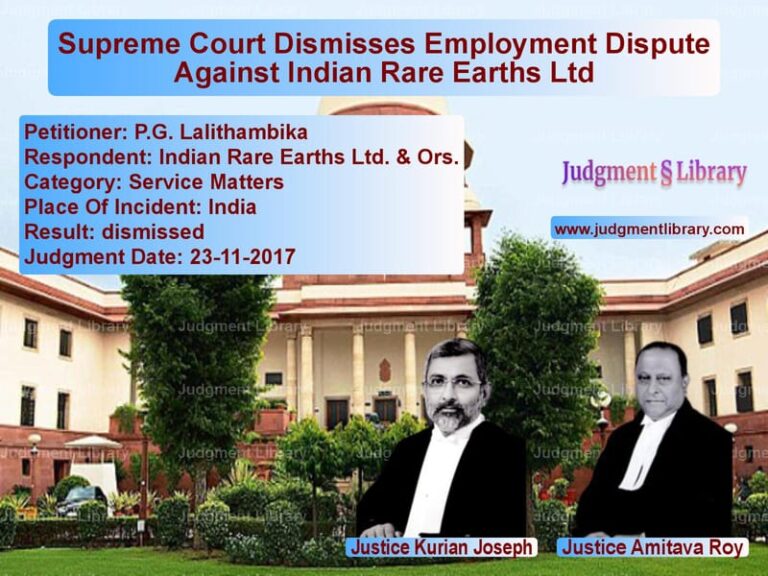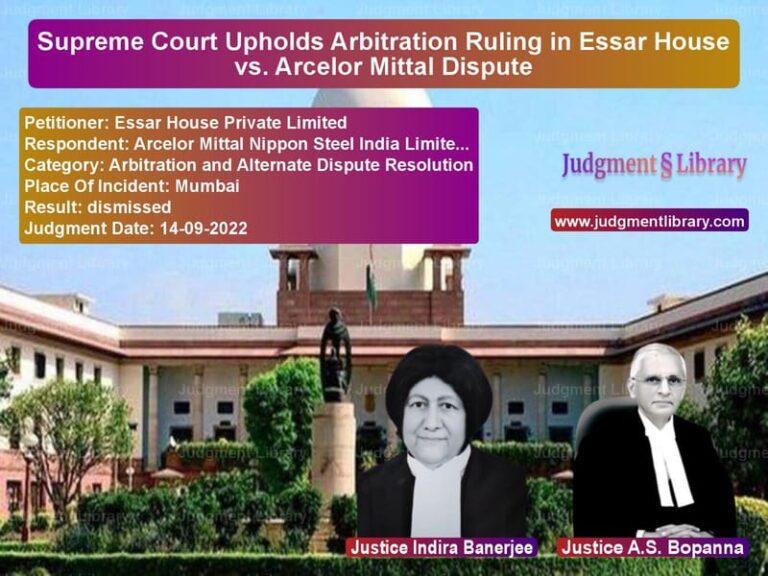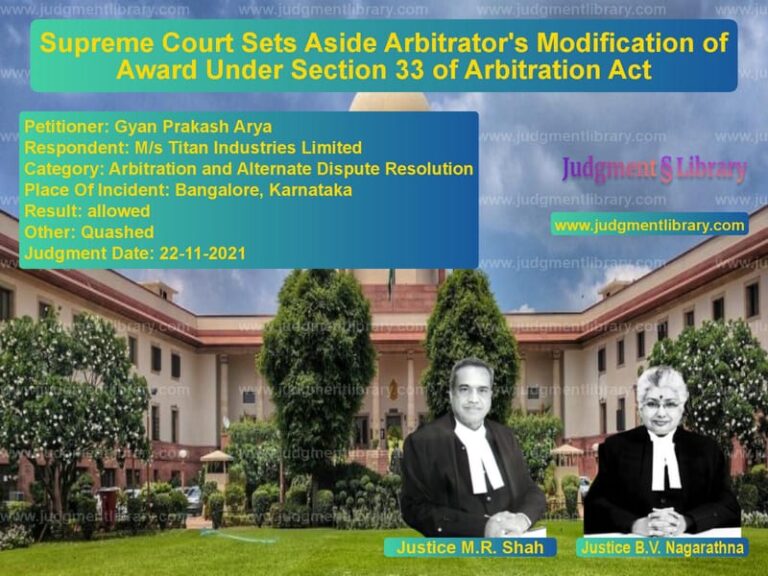Supreme Court Acquits Accused in Assam Murder Case Due to Lack of Evidence
The Supreme Court of India, in its judgment dated May 23, 2017, in the case of Anjan Kumar Sarma & Others vs. State of Assam, overturned the conviction of the accused under Section 302 of the Indian Penal Code (IPC) and acquitted them due to insufficient evidence. The case, which revolved around the alleged murder of a woman, Rekha Dutta, was based on circumstantial evidence. The Court ruled that the prosecution failed to establish a complete chain of evidence to prove the guilt of the accused beyond a reasonable doubt.
Background of the Case
The case pertained to the alleged murder of Rekha Dutta, whose mutilated body was found on a railway track near Gotanga Tea Estate, Assam, on December 29, 1992. The prosecution claimed that the accused, including Jitendra Nath Kakati (Jit Kakati) and three others, had raped and murdered the victim before dumping her body on the railway tracks to destroy evidence. The accused were initially acquitted by the trial court, but the High Court reversed the decision and convicted them under Section 302 and 201 read with Section 34 of IPC, sentencing them to life imprisonment. The accused then appealed to the Supreme Court.
Legal Issues Examined
The Supreme Court considered several key legal questions:
- Whether the prosecution had established a complete chain of circumstantial evidence linking the accused to the crime.
- Whether the ‘last seen together’ theory was sufficient to convict the accused in the absence of direct evidence.
- Whether the High Court was justified in overturning the acquittal by the trial court.
- Whether the absence of forensic evidence weakened the prosecution’s case.
Arguments by the Appellants
- The appellants contended that there was no direct evidence linking them to the crime.
- They argued that the prosecution relied solely on circumstantial evidence, which was incomplete and inconclusive.
- The forensic report did not conclusively establish that the weapon recovered was used in the crime.
- The trial court had correctly analyzed the evidence and found no proof of guilt beyond a reasonable doubt.
Arguments by the Respondent (State of Assam)
- The prosecution argued that the accused were last seen with the deceased on the evening of December 27, 1992.
- It claimed that the accused had failed to provide any explanation for the victim’s whereabouts after that evening.
- The prosecution relied on the discovery of the deceased’s severed body parts and forensic evidence to establish that she was murdered before being placed on the railway tracks.
Supreme Court’s Observations
The Supreme Court analyzed the evidence presented and made the following key observations:
- The trial court had found that the accused were last seen with the deceased at 9:00 pm on December 27, 1992, but there was no proof of their involvement beyond that time.
- The prosecution failed to establish when the deceased was killed, as the post-mortem report only indicated an estimated time of death between 24 to 48 hours before the autopsy.
- The recovery of a knife (Khukri) allegedly used in the crime was not backed by conclusive forensic evidence.
- The presence of blood stains in the bungalow of one of the accused was inconclusive, as forensic tests did not confirm it was human blood.
- The prosecution did not establish any motive for the accused to commit the crime.
Final Judgment
The Supreme Court ruled in favor of the appellants, setting aside the High Court’s judgment and restoring the acquittal. The key rulings included:
- The ‘last seen together’ theory, by itself, was insufficient to establish guilt.
- The prosecution failed to present a complete chain of circumstantial evidence leading only to the conclusion that the accused committed the crime.
- Suspicion, however strong, cannot replace legal proof in criminal trials.
- The appellants were directed to be released immediately unless required in other cases.
Implications of the Judgment
This judgment has significant implications for criminal law and the burden of proof in cases based on circumstantial evidence:
- Reinforcement of the Burden of Proof: The ruling highlights that the prosecution must establish guilt beyond a reasonable doubt, especially in cases based solely on circumstantial evidence.
- Limitations of the ‘Last Seen Together’ Doctrine: The decision clarifies that merely being last seen with the deceased does not automatically imply guilt.
- Protection Against Wrongful Conviction: The judgment reinforces that courts must exercise caution when overturning acquittals, particularly when the evidence is weak.
Conclusion
The Supreme Court’s ruling in Anjan Kumar Sarma & Others vs. State of Assam underscores the fundamental principles of criminal justice, emphasizing that suspicion cannot substitute for proof. By acquitting the accused, the Court reaffirmed that every individual is presumed innocent until proven guilty beyond a reasonable doubt. This judgment sets an important precedent for future cases where convictions are based on circumstantial evidence.
Don’t miss out on the full details! Download the complete judgment in PDF format below and gain valuable insights instantly!
Download Judgment: Anjan Kumar Sarma & vs State of Assam Supreme Court of India Judgment Dated 23-05-2017.pdf
Direct Downlaod Judgment: Direct downlaod this Judgment
See all petitions in Murder Cases
See all petitions in Attempt to Murder Cases
See all petitions in Custodial Deaths and Police Misconduct
See all petitions in Judgment by L. Nageswara Rao
See all petitions in Judgment by Navin Sinha
See all petitions in allowed
See all petitions in Quashed
See all petitions in supreme court of India judgments May 2017
See all petitions in 2017 judgments
See all posts in Criminal Cases Category
See all allowed petitions in Criminal Cases Category
See all Dismissed petitions in Criminal Cases Category
See all partially allowed petitions in Criminal Cases Category







